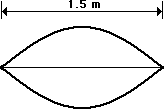A standing wave is formed when ____.
a. a wave refracts due to changes in the properties of the medium.
b. a wave reflects off a canyon wall and is heard shortly after it is formed.
c. red, orange, and yellow wavelengths bend around suspended atmospheric particles.
d. two identical waves moving different directions along the same medium interfere.
D
Suppose that a string is 1.2 meters long and vibrates in the first, second and third harmonic standing wave patterns. Determine the wavelength of the waves for each of the three patterns.
First harmonic: 2.4 m
Second harmonic: 1.2 m
Third harmonic: 0.8 m
Stan Dinghwaives is playing his open-end pipe. The frequency of the second harmonic is 880 Hz (a pitch of A5). The speed of sound through the pipe is 350 m/sec. Find the frequency of the first harmonic and the length of the pipe.
Given: 2nd Harmonic frequency f2 = 880 Hz
v = 350 m/s
λ = v / f = (350 m/s) / (440 Hz) = 0.795 m
L = 0.5 • λ = 0.398 m
Titan Tommy and the Test Tubes at a night club this weekend. The lead instrumentalist uses a test tube (closed-end air column) with a 17.2 cm air column. The speed of sound in the test tube is 340 m/sec. Find the frequency of the first harmonic played by this instrument.
Given:
v = 340 m/s
L = 17.2 cm = 0.172 m
λ = 4 • L = 4 • (0.172 m) = 0.688 m
f1 = v / λ = (340 m/s) / (0.688 m) = 494 Hz
The number of nodes in the standing wave shown in the diagram is ____.
a. 6
b. 7
c. 8
d. 14

C
The string at the right is 1.5 meters long and is vibrating as the first harmonic. The string vibrates up and down with 33 complete vibrational cycles in 10 seconds. Determine the frequency, period, wavelength and speed for this wave.

f = (33 cycles) / (10 seconds) = 3.3 Hz
The period is the reciprocal of the frequency.
T = 1 / (3.3 Hz) = 0.303 seconds
W = 2 • L = 2 • (1.5 m) = 3.0 m
v = f • W = (3.3 Hz) • (3. 0 m) = 9.9 m/s
On a cold frigid day, Matthew blows on a toy flute, causing resonating waves in an open-end air column. The speed of sound through the air column is 336 m/sec. The length of the air column is 30.0 cm. Calculate the frequency of the first, second, and third harmonics.
Given: v = 336 m/s
L = 30 cm = 0.30 m (use meters for length since the speed is given in units of meters/s)
λ = 2 • L = 2 • (0.30 m) = 0.60 m
f1 = v / λ = (336 m/s) / (0.60 m) = 560 Hz
Second harmonic: f2 = 1120 Hz
Third harmonic: f3 = 1680 Hz
A closed-end organ pipe is used to produce a mixture of sounds. The third and fifth harmonics in the mixture have frequencies of 1100 Hz and 1833 Hz respectively. What is the frequency of the first harmonic played by the organ pipe?
Given:
f = 1100 Hz (3rd Harmonic)
f = 1833 Hz (5th Harmonic)
f1 = (1100 Hz) / 3 or (1833 Hz) / 5 = 367 Hz
The number of antinodes in the standing wave shown in the diagram is ____.
a. 6
b. 7
c. 8
d. 14

B
The string at the right is 6.0 meters long and is vibrating as the third harmonic. The string vibrates up and down with 45 complete vibrational cycles in 10 seconds. Determine the frequency, period, wavelength and speed for this wave.

f = (45 cycles) / (10 seconds) = 4.5 Hz
The period is the reciprocal of the frequency.
T = 1 / (4.5 Hz) = 0.222 seconds
W = (2 / 3) • L = (2 / 3) • (6.0 m) = 4.0 m
v = f • W = (4.5 Hz) • (4. 0 m) = 18 m/s
A flute is played with a first harmonic of 196 Hz (a pitch of G3). The length of the air column is 89.2 cm (quite a long flute). Find the speed of the wave resonating in the flute.
Given: L = 89.2 cm = 0.892 m (use meters for length since the speed is given in order to calculate speed in units of meters/second)
f = 196 Hz (1st harmonic)
λ = 2 • L = 2 • (0.892 m) = 1.784 m
v = f • λ = (196 Hz) • (1.784 m)
v = 349.66 m/s = 3.50 x 102 m/s
Pipin' Pete is playing at City Park next weekend. One of the closed-end pipes is capable of sounding out a first harmonic of 349.2 Hz. The speed of sound in the pipe is 350 m/sec. Find the length of the air column inside the pipe.
Given: f = 349.2 Hz (1st H)
v = 350 m/s
λ = v / f = (350 m/s) / (349.2 Hz) = 1.00 m
L = 0.25 • λ = 0.250 m
Consider the standing wave pattern at the right in answering these next two questions.
5. The number of nodes in the entire pattern is ___.
a. 7
b. 8
c. 9
d. 16

C
Of all the labeled points, destructive interference occurs at point(s) ____.
a. B, C, and D
b. A, E, and F
c. A only
d. C only
e. all points

A